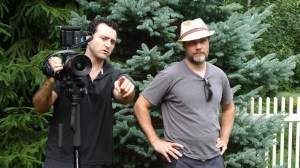
“Our Canon EOS C100 cameras provided the compact form factor we needed to move quickly,” von Scheele explained. “We shot in attic bedrooms, in cars, in bathrooms, and other tight spaces. The size of the EOS C100 camera let us experiment much more easily because we could play around with different angles. The EOS C100 camera also has a really nice low-light factor. Without huge, hot lights, light stands and big crews you can create a much smaller, quieter and less obtrusive space for the actors to focus on their performances. Plus, the EOS C100 camera gave us the ability to shoot in Canon Log for the picture quality we wanted.”
“We definitely had a lot more freedom than if we had shot with a larger camera and crew, and more lights,” Khoury added. “The more you add to the production, the more time and money it takes. The Canon EOS C100 cameras are small, they let us shoot with less light, get closer to walls and they don’t require as many add-ons, so we could tell the story we wanted to tell without needing to make it a massive production exercise. It’s always nice to have more money and toys to play with, but sometimes when you have limitations it forces you to find creative solutions instead of just throwing more money at the project. I think a lot of filmmakers are embracing smaller productions because they make it easier to tell the story you want told.”
The low-light and cinematic imaging capabilities of the Canon EOS C100 camera are made possible by its 16:9 Canon Super 35mm CMOS image sensor and the Canon DIGIC DV III Image Processor.
“I think we shot the entire film at an ISO of 850,” von Scheele recalled. “There were one or two scenes that went to 1000 ISO, but that was more just to get the right aperture than because we needed more light. What was really nice was to be able to shoot with practicals – lights that are part of your set or location – that you can’t control. When you’re on the street you can just shoot with streetlights or whatever illumination is already there. We shot a lot of stuff on the street at night and that was really convenient. Many of our choices in adding lights were not done to get a better exposure on our Canon EOS C100 cameras, but because we wanted to manipulate the ratio of the light. For me, one of the best qualities of the EOS C100 camera is its three built-in ND filters. It’s important to have an aperture that helps sculpt the characters out of the background. That’s why it’s nice to be able to – in any situation – stop-down on the aperture when you can’t control the presence of too much light. We often shot with three of the ND’s – particularly when we were outside – and even in certain daylight indoor scenes we used an ND 1.”
The Canon EOS C100 Cinema camera features three built-in ND filters (2, 4, and 6 stops, and OFF) that can be deployed using a manual dial.
“The ND filters enabled us to basically shoot at a lower f stop and get less depth-of-field so the background would be more out of focus compared to the characters, making them really pop,” said Khoury regarding the bokeh effects he accentuated with those filters.
Khoury and von Scheele found that the ability to choose among Canon’s wide range of CN-E and EF-series lenses for the EF-mount Canon C100 Cinema camera was also a major creative advantage for shooting All Relative.
“You can theoretically put almost any still photography lens on the Canon EOS C100 Cinema camera and get great picture quality,” von Scheele noted. “In the indie world this can save you a lot of money. We used the Canon CN-E 24mm, CN-E50mm, and CN-E85mm Cinema primes, the Canon EF 14mm f/2.8L II USM ultra-wide-angle, EF 8-15mm f/4L fisheye USM, and EF 100mm f/2.8 macro lenses. The sharpness was very similar, there weren’t noticeable differences and they all intercut really well.”
The filmmakers relied on their Canon EF 14mm ultra-wide-angle lens for shots of the Manhattan skyline and establishing shots of the exterior of their suburban location home.
“That 14mm wide-angle lens gives you a really amazing sense of space,” von Scheele said. “Architecture looks really nice when you get more of it in the picture, but shooting a house can be hard because a lot of times you can’t really go back that far before you hit the street or another property.”
The filmmakers explained that the Canon EF 100mm f/2.8 macro lens was used for a variety of extreme close-ups.
The Canon EOS C100 Cinema camera features an industry-standard AVCHD codec, recording 1920 x 1080 HD using MPEG-4 AVC/H.264 compression at data rates of up to 24-Mbps to two SD cards. The filmmakers recorded their footage both to the cards and to an Atomos Ninja 2 HDMI recorder.
“When you’re shooting Canon Log, you really want to get that dynamic range, and the Ninja gives you a little bit more latitude than the cards,” Khoury said. “The EOS C100 camera makes great images and Canon Log gave us a lot more space and dynamic range to play with. Our images held up quite well in post.”
“All of our Canon equipment worked great,” Khoury added. “These days, you don’t need millions and millions of dollars to make a high-quality movie that people will want to see. The EOS C100 is a great camera when you’re working on a lower budget.”





